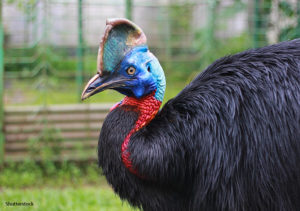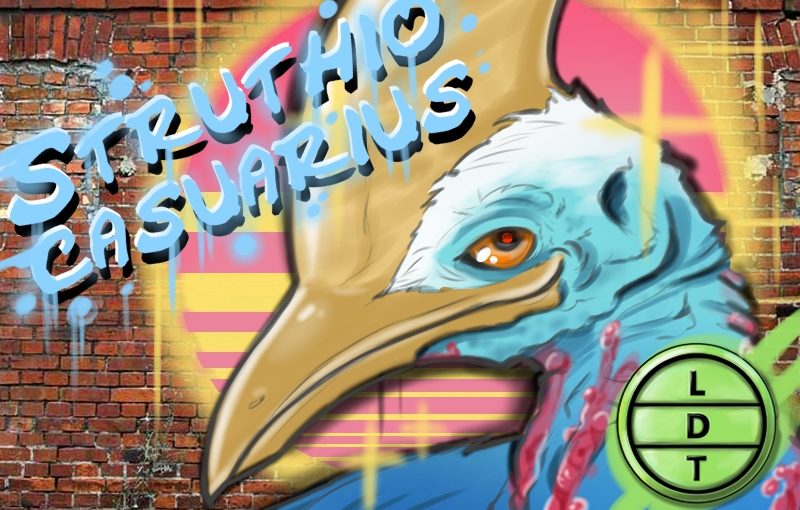“…and today we’re talking about what is called the most dangerous bird in the world. But more on the truth of that later.”
We often think of birds as benign, graceful creatures, alighting on the forefingers of princesses and singing songs to one another as the sun crests the horizon. When in danger, these skittish creatures take to the air and find safety in the sky or even a tall tree. But not every bird is so gentle. And not every bird flees from a fight. One bird breaks the cultural standards of birdliness and kicks elegance to the curb. But strength and aggression is often a path to survival in Life, Death, and Taxonomy.
The cassowary is one of the strangest birds you’ve ever seen, and also one of the coolest. With news of a cassowary killing a man in Gainesville this past week, many are wondering what kind of bird is capable of such a thing. By the end of this, and the Life, Death, and Taxonomy episode we published about the bird, you’re sure to be convinced of how dangerous this exotic avian truly is.
What Does a Cassowary Look Like?

If the picture above isn’t enough, or if it won’t load for some reason (update your JavaScript!). Then here is a beautiful word picture of the oddest-looking bird on two legs.
The cassowary (southern style) is a large, flightless bird that mostly resembles an ostrich in its shape. However, the body is proportionately larger and the neck is shorter. That very same body is covered in bristle-like black feathers that make the cassowary look like it has a slick, greased-back hairdo.
Here is where things get interesting. The southern cassowary has a long and slender neck with dry, scaly skin that is bright blue. Just picture the fleshy skin of a turkey or a vulture, but this time it’s blue. Dangling from that azure neck is a “gobble” of loose hanging skin that is bright red. Go back to that visual of the vulture, and just skip the part about changing it to blue.
Atop this stark blue and red neck sits a head that houses a black conical beak, beautiful amber eyes, and long eyelashes that aren’t as much eyelashes as they are eye feathers.
To literally top things off, the southern cassowary is crowned with a large vertical crest that runs the length of its head from just above its eyes to the back of its head. This crest (called a casque) can be seven inches high. It’s made of keratin and is covered in greyish skin. Inside, the casque is sponge-like, with fibers crisscrossing from side to side.
Ornithologists are split on the reason for this casque. Some say that it is used to help the cassowary push underbrush aside as it moves through the jungle. Others say that it serves as protection during mating combat and from falling fruits and seeds. However, the most likely reason is to facilitate the weirdest bird call you’ve ever heard. Seriously, if you don’t believe us, just listen to the behemoth in this video.
Lastly, the cassowary is supported by two long, powerful legs that help it run over 30 miles per hour and kick most enemies to death. It has three toes, the middle one sporting a 5-inch super-sharp claw especially made for killing.
Cassowary Size
The cassowary is one of the largest birds on the planet. It’s not quite as big as an ostrich, but it’s pretty close. Its size lives between the emu and ostrich, putting it at a max height of over 6 feet 6 inches! It also weighs in at a whopping 130 pounds, making it also one of the heaviest birds in the world. While this makes it impossible for it to fly, it can certainly chase you down lickety split.
Where Does it Live?
The southern cassowary makes its home in Australia and the islands just north of it including New Guinea and Indonesia. It likes dense jungles with thick undergrowth for foraging and hiding.
The cassowary’s diet is mostly made up of fruit, as it spends a lot of time under fruit trees eating what’s fallen on the ground. However, it won’t shy away from eating small animals like rodents, snails, insects, frogs, as well as plants like flowers. Overall, this massive bird is a true omnivore.
How Dangerous is a Cassowary?
Now that we’ve learned more about this elusive creature, let’s talk about how dangerous it is.
On April 12, 2019, 75-year-old Marvin Hajos was tending to his cassowaries in his backyard in Gainesville, Florida. Hajos was breeding and selling specimens of the exotic bird to collectors and was feeding his stock. When he tripped and fell into a hole in the backyard, one of the birds jumped in after him and injured him. When first responders got Hajos to the hospital, he died due to his injuries.
While this probably serves as a sad cautionary tale about handling exotic wildlife without proper experience, it also shows just how dangerous the cassowary can be. That being said, there has only been one other reported instance of a cassowary killing a human, and that was in the 1920s when a boy fell and had his jugular severed by the bird’s knife-like talon. However, there may be many more unrecorded instances of aborigines and native Papua New Guineans being killed by cassowaries.
Cassowaries are generally very shy animals, and most flee as soon as they smell trouble and are long gone before humans even realize that they were there. But if cornered (and particularly, if you get between them and their food), they are liable to lash out. These birds have daggers in their toes and can jump over 7 feet straight into the air to deliver a kick that has the potential to disembowel enemies. Not to mention the fact that females are extremely territorial and can’t stand having another female nearby.
That being said, the males do make great fathers! They stick by the chicks after hatching and defend them for over nine months.
Measure Up
Female height – 2 m (6.6 ft) – How many cassowaries would go into the total height of the largest didgeridoo ensemble ever, assuming they were all the average human height (400.9 m or 1,315.3 feet) and stacked on top of eachother. Hint: The ensemble took place at Didge Fest in 2006 in Devon in the UK. Answer: 199.28 birds
Female Weight – 58.5 kg (130 lb) – How many of the heaviest chicken egg (454g, 16 oz) ever recorded go into the weight of a cassowary? Hint: The egg was laid by a hen in Vineland, New Jersey. It had two yolks and a double layered shell. Answer: 130 eggs
Major Fact
On a sunny Friday morning in Gainesville, FL, a call was made to local police reporting that 75-year-old Marvin Hajos was attacked by a large bird. Police and emergency services arrived on the seen to find the man gravely injured by one of the two Cassowaries on his property. The birds were corralled as Hajos was transported to the hospital where he later died of his injuries.
The event last week was the second time one of these birds has killed a person since April 6, 1926, when 16-year-old Phillip McClean tried to kill the bird with is little brother when they found it on their property in Australia. He fell to the ground and the bird kicked him in the neck, cutting the jugular vein.
The cassowary is called the most dangerous bird in the world for a number of reasons.
-
- Their size makes them formidable, even for adult humans.
-
- They have powerful legs that allow them to jump seven feet in the air and run at 30 mph.
-
- Legs that can allows a 160 animal to move like that can also deliver powerful kicks.
-
- These kicks are augmented by a three-toed foot that each has a straight dagger-like claw that is able to stab and slice enemies.
- When they aren’t fighting, they use these claws to dig and uncover fallen fruit in forest underbrush.
- These kicks are augmented by a three-toed foot that each has a straight dagger-like claw that is able to stab and slice enemies.
-
- When they attack, they may jump up and kick around a person’s mid-section. However, as with both fatalities the most dangerous blows came after the person fell to the ground.
- Dogs and other animals that are low to the ground are also vulnerable to kicks.
An ornithologist named Ernest Thomas Gilliard described cassowaries in his 1958 book Living Birds of the World. He is quoted saying:
“The inner or second of the three toes is fitted with a long, straight, murderous nail which can sever an arm or eviscerate an abdomen with ease. There are many records of natives being killed by this bird.”
The raw destructive power he describes seems a bit overblown considering they have only killed two people in nearly a century. But they are dangerous and they can be aggressive.
-
- A study in 2003 looked at the recorded attacks throughout history and found a total of 221 attacks on people and domestic animals.
-
- 150 had been against humans.
-
- Many of the attacks were food driven. The birds were either being fed by people, had been fed by humans before, were expecting food, or were defending natural food sources.
-
- 15% were cases of self-defense.
- 7% involved defending chicks or eggs.
The Florida Fish and Wildlife Conservation Commission lists the bird as Class II Wildlife along with wolves, coyotes, jackals, wolverines, badgers, and bobcats.
-
- Class II involves animals that can be dangerous to humans and requires “substantial experience” to safely handle.
- The only other bird in this class is the ostrich, which is bigger than a cassowary and may be equally as dangerous.

